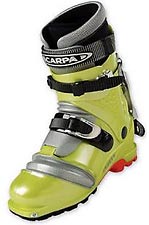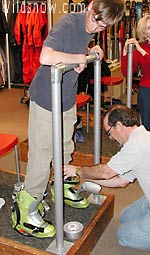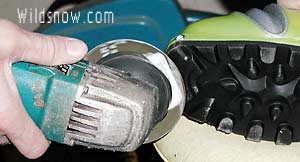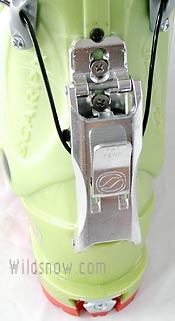
Scarpa F1 ski touring boot circa 2004 2005.
As I skin climbed up the ski resort groom on a test mission, a novice telemarker stopped nearby. “Can I get some telemark tips from you?” he said as I chugged past him. I was charging uphill, breathing hard. He must have thought that if I had the lungs to go uphill, perhaps I knew something he didn’t about the downhill. “I don’t telemark,” I said as I stopped for a moment. Next question was inevitable: “What kind of gear is that then?” “It’s rando buddy,” I replied, “fastest uphill and the most fun down.” “Cool,” said the telemarker as he skied away. Another religious conversion? I hope so, because this stuff works and everyone should at least try it once before they make uninformed judgments about tele vs. Randonnée (and other life changing dilemmas such as lager vs. ale).
What confused the telemarker were my Scarpa F1 randonnee skimo boots. With a forefoot bellows to allow metatarsal flex, they look just like telemark boots. And since I was going uphill, I can’t really blame the guy for thinking I was a tele boy.
That day I also had a pair of Dynafit TLT bindings mounted on a pair of lightweight 160 cm skis. Along with my waxed skins, carbon fiber poles and featherlight pack, I was smiling as I charged — feeling fast and light, knowing when I got to the top I’d latch down my heels and fly down the hill while working on the carving technique a ski guru had been teaching me. Today, the uphill was about feeling free, and the downhill was all about the arc — thanks to state-of-art gear that even a few years ago few people dreamed was possible

The F1 comes with a thermo-form liner. Here, Louie Dawson gets custom fitting from Aspen’s elite boot fitter Bill Thistle — Performance Alignment Systems. Yes, the boy got a pair as well — and likes ’em!
Fitting
I’ve spent more than thirty ski seasons in a variety of randonnee boots — everything from leather ski boots, to the lightest Dynafit, to early and incredibly heavy Lowas. All had a stiff sole — an important part of boot design that allows alpine bindings to function properly, give the boot torsional rigidity, and is also useful in climbing mode for kicking steps and front-pointing on crampons. Nonetheless, back during my several seasons as a telemarker (ancient history) I’d experienced the comfort you get from a leather boot that bends at the ball of the foot, and I’d always wondered if a little bit of metatarsal flex might make randonnee ski climbing more efficient, or at least more comfortable (instead of the “frankenstride” that rando bindings force on us, to one degree or another).
Enter the Scarpa F1, a randonnee boot with flexible sole and bellows similar to today’s plastic telemark boots.
Introduced a few years ago in Europe, specifically for randonnee racing (fast up and fast down), the F1 has a flexible sole and bellows like a telemark boot, but includes fittings for the Dynafit randonnee binding, is super-light*, and has a unique one-in-all mode latch that in one motion bundles your foot for the downhill or releases the boot cuff for the uphill.

Installing shim under ball of foot, necessary for binding function while using F1 boot.
F1 randonnee ski touring boot shim
For my test rig I grabbed a pair of Dynafit Carve Lite skis from the quiver and mounted them with TLT bindings. Nothing tricky here, but you do have to install a shim under the boot sole so the boot doesn’t sag down while in alpine mode, causing funny behavior and unintended release (Dynafit bindings suspend the boot between toe and heel, usually with no support in between, so a bellows will sag with no support.)
The boots come with two sets of shims in the box, one for the TLT binding, and one (thicker) for the Comfort. Additional shims are available if you’re mounting more than one pair of skis. Once the shim is installed the Dynafit binding will still work for other randonnee boots, but you may have to shave a bit of rubber off the soles of other boots so there is clearance above the shim while the boot/binding is in flat-on-ski mode.
While the shim has the intended effect of supporting the boot in alpine mode, it can cause additional friction in lateral release — thus the caveat that an F1 rig is for good skiers who seldom fall, and who don’t plan on banging major vertical at resorts. (If you’re after a more versatile setup, stick with conventional ski touring backcountry boots used with any of the top rando bindings, such as Dynafit or Fritschi.)
Next, the parking lot, where walking around in the F1 was definitely wonderful. They felt more like a pair of hiking boots than anything close to ski boots. Beers at the trailhead after a tour? I’ll keep these boots on, relax, then change shoes after the party.

The “trigger” area of the F1 boot sole actuates the Dynafit binding when you enter it. On my boots it was slightly too thick, and made it hard to exit the binding. A touch with 30-grit took care of the problem.
The first thing I noticed on the uphill was a slightly more natural stride, somewhat similar to that provided by the double pivot Naxo binding, but even more comfortable. When initiating a step the boot bellows compresses a bit, and the stroke completes by swinging on the effortless pivot of the Dynafit bindings — basically, the best of both telemark and alpine worlds. This same action is becoming available in telemark bindings with “touring release,” and is definitely something positive. In a word it adds comfort, though how much energy it saves over a stiff soled rando boot is open to debate — and I’m pretty certain it is minimal or even zilch. Why? Because even if the more natural stride saves a smidgen of energy, when you engage the Dynafit binding heel lift, the F1 sags at the ball of the foot every time you start a stride (as telemark boots do when using a climbing lift), thus using up a small amount of umpf. I compensated for this by using good skinning technique and keeping my weight back on my heels, but doing so obviated much of the comfort I was getting from the F1’s metatarsal flex.
But the comfort is what I really noticed. On the flat sections I switched the binding to heel-on-ski mode and was able to make remarkably efficient nordic style strides. Steeper, and the comfortable flex definitely contributed to my enjoying the uphill.

Scarpa F1 lean lock, original version shown here has been improved over the years.
F1 lean-lock pulls on the cables to tighten cuff, catch at bottom engages a slot to lock lean for downhill skiing.
At the top of my climb I tested the F1 all-in-one tour/ski latch. This ingenious rig works by running a cable to a long aluminum lever on the back of the cuff. You jam the lever down to provide the usual randonnee lean lock, and as you do it pulls the cable and snugs down the cuff of the boot as if you were operating a separate buckle. It works, but the downside is that getting in and out of the boots requires a bit of fiddling to thread the end of the cable into an anchor — well and good in normal circumstance, but a potential cuss inducing fiddle with gloved hands in extreme conditions. Randonnee races are sometimes won and lost in the uphill/downhill transitions, so this mechanism is an effort to trim time from such. Is it necessary for normal ski touring? Probably not, but if you’re doing laps it will save some time.
The downhill is where any randonnee boot gets my make or break opinion. Beefier boots will always ski well if they’re fitted correctly and skied with the correct forward lean, ramp angle, etcetera. But lighter boots can be dogs if they don’t include some tricky engineering for making turns.
I expected the F1 flexible sole to do something funny during latched heel turns, but other than feeling a small amount of movement, it seemed to have little effect. But, and it’s a big BUT, this is not a “powerful” boot. While the F1 is the same height and has as stiff a cuff as, say, a Scarpa Laser, the F1’s combination of thinner liner and overall lack of mass make this a boot for modern style, wherein one works at urging the skis to turn themselves, rather than aggressively throwing a knee into a turn, or harshly pressuring the tongue of the boot. That said, the huge lean-lock mechanism seems to act as an exoskeleton, and provides more control and beef than one would assume when looking at the lightweight and trim F1.
I love learning to ski this “new” way, so score one for the F1 in my book. Nonetheless, in steep terrain or difficult snow — situations where one has to aggressively force skis to turn — any lightweight boot may be too much of a compromise. How to know what’s true for you? Trying boots out as a shop demo is recommended. If you can’t demo, you’ll just have to analyze your style and buy accordingly. If you ski fast, in difficult snow and steep terrain, I’d stick with a conventional randonee boot. If you go for more mellow terrain and max vertical, or spend a lot of time walking or standing in your boots (such as working outdoor education, or ski coaching) consider the F1. And if you race uphill and down, is there any other choice?
(*Weight: I compared shell weight of same size Scarpa Laser with the F1. The Laser shell is about 1 ounce heavier than the F1. With thermo liner, the Laser is several more ounces heavier due to it’s higher and thicker liner. Not a huge difference, but all weight adds up. The Scarpa custom-shop makes a sponsored racers version of the F1, it’s drilled with speed holes and has a lighter weight tongue — good for a few hundredths of a second during a race, but probably no big deal for touring. And yes, I did try making a few telemark turns with my F1 rig. I could fake it, but because of the free-hinging Dynafit tour pivot obviating ball-of-foot ski control, making a real telemark turn was a joke and did not result in a religious conversion.)
WildSnow.com publisher emeritus and founder Lou (Louis Dawson) has a 50+ years career in climbing, backcountry skiing and ski mountaineering. He was the first person in history to ski down all 54 Colorado 14,000-foot peaks, has authored numerous books about about backcountry skiing, and has skied from the summit of Denali in Alaska, North America’s highest mountain.
